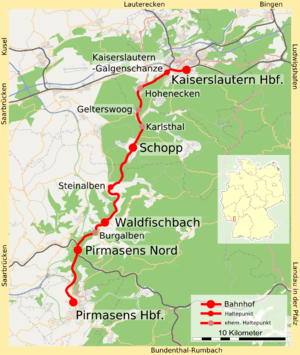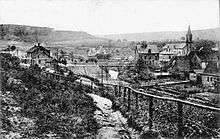Biebermühl Railway
| Kaiserslautern–Pirmasens | ||||||||||||||||||||||||||||||||||||||||||||||||||||||||||||||||||||||||||||||||||||||||||||||||||||||||||||||||
|---|---|---|---|---|---|---|---|---|---|---|---|---|---|---|---|---|---|---|---|---|---|---|---|---|---|---|---|---|---|---|---|---|---|---|---|---|---|---|---|---|---|---|---|---|---|---|---|---|---|---|---|---|---|---|---|---|---|---|---|---|---|---|---|---|---|---|---|---|---|---|---|---|---|---|---|---|---|---|---|---|---|---|---|---|---|---|---|---|---|---|---|---|---|---|---|---|---|---|---|---|---|---|---|---|---|---|---|---|---|---|---|---|
 | ||||||||||||||||||||||||||||||||||||||||||||||||||||||||||||||||||||||||||||||||||||||||||||||||||||||||||||||||
| Overview | ||||||||||||||||||||||||||||||||||||||||||||||||||||||||||||||||||||||||||||||||||||||||||||||||||||||||||||||||
| Locale | Rhineland-Palatinate, Germany | |||||||||||||||||||||||||||||||||||||||||||||||||||||||||||||||||||||||||||||||||||||||||||||||||||||||||||||||
| Line number |
| |||||||||||||||||||||||||||||||||||||||||||||||||||||||||||||||||||||||||||||||||||||||||||||||||||||||||||||||
| Technical | ||||||||||||||||||||||||||||||||||||||||||||||||||||||||||||||||||||||||||||||||||||||||||||||||||||||||||||||||
| Line length | 35.9 km (22.3 mi) | |||||||||||||||||||||||||||||||||||||||||||||||||||||||||||||||||||||||||||||||||||||||||||||||||||||||||||||||
| Track gauge | 1,435 mm (4 ft 8 1⁄2 in) standard gauge | |||||||||||||||||||||||||||||||||||||||||||||||||||||||||||||||||||||||||||||||||||||||||||||||||||||||||||||||
| Route number | 672 | |||||||||||||||||||||||||||||||||||||||||||||||||||||||||||||||||||||||||||||||||||||||||||||||||||||||||||||||
| ||||||||||||||||||||||||||||||||||||||||||||||||||||||||||||||||||||||||||||||||||||||||||||||||||||||||||||||||


The Biebermühl Railway (German: Biebermühlbahn)—sometimes called the Moosalbbahn (Moosalb Railway)—is a 35.9 km long railway line from Kaiserslautern to Pirmasens in the German state of Rhineland-Palatinate, which was built between 1875 and 1913. The first section between Biebermühle (now Pirmasens Nord station) and Pirmasens connected the city of Pirmasens to the railway network, which could only be achieved via a branch line due to the topography. In 1905, another branch was opened from Biebermühle to Waldfischbach, which was extended in 1913 to Kaiserslautern. It was subsequently used by national services, which operated until 1990. Since then, it has been used only by local services.
Route
The Biebermühl Railway runs along the western edge of the Palatinate Forest (Pfälzerwald), through the Sickingen Heights (Sickinger Höhe). It is largely surrounded by forest over the whole route. From the abandoned Karlsthal station it runs along the Moosalb until its confluence with the Schwarzbach in Waldfischbach-Burgalben. The line then runs to Pirmasens Nord station. The remaining nearly seven kilometres of line cuts through relatively steep terrain and includes the 887 metres long New Fehrbach tunnel to reach the terminal station of Pirmasens.
From Kaiserslautern station to the abandoned Gelterswoog station the line is located within the boundaries of the urban district of Kaiserslautern and from Karlsthal to Schopp in the district of Kaiserslautern. Between Steinalben and Pirmasens Nord it runs through the district of Südwestpfalz, while the remainder of the line is located on the territory of the city of Pirmasens.
Gelterswoog and Karlsthal stations mainly served natural attractions and were thus primarily served by tourist services. For this reason, both have been abandoned. Groups can stop at the latter on request.
History
Branch line to Pirmasens (1860–1900)
The city of Pirmasens hoped to obtain a connection to the railway network as part of the planned Southern Palatinate Railway (Südpfalzbahn) between Landau and Zweibrücken. It turned out that this had to be ruled out because of the difficult topography of the Palatinate Forest. A direct link to the Southern Palatinate Railway would have required a station far outside the city, which would have required expensive tunnels. The majority of the city council voted for a branch line to a nearby station, as proposed by the Bavarian government.[2]
On 25 November 1875, the first section of the Biebermühl Railway was opened as a 6.97 km-long line from Biebermühl (now Pirmasens Nord) station to Pirmasens as single-track branch line; it was opened on the same day of the last section of the Southern Palatinate Railway. As traffic grew on the branch line, Pirmasens station had to be expanded, because the original station building was no longer adequate. Like the Southern Palatinate Railway, the branch line to Pirmasens initially mainly served freight traffic.
Connection to Kaiserslautern and the period up to 1945
Already in the 1860s, the district council of Waldfischbach had criticised the proposed Landau–Zweibrücken route.[3] Around the same time Pirmasens had considered a connection to Kaiserslautern.[4]
On 1 June 1904, the Biebermühl Railway was extended as a 5.13 km long branch line from Biebermühl to Waldfischbach with one intermediate stop at Burgalben. Thus, Biebermühl became a junction station. In 1909, the Royal Bavarian State Railways (Königliche Bayerische Staats-Eisenbahnen) took over railway operations in the Palatinate. On 1 August 1913, the gap was closed between Waldfischbach and Kaiserslautern.
In 1907, Pirmasens station was officially renamed as Pirmasens Hauptbahnhof (normally translated as “Pirmasens Central Station”). After the First World War, the Palatine railways were operated by the French government from 1920 to November 1924. In 1936, Biebermühl station was renamed Pirmasens Nord, although it is still not within the boundaries of the city of Pirmasens. In 1939, a second track was built between Pirmasens and Pirmasens Nord, but on a separate line. It runs at a different altitude and with a more uniform grade in order to avoid too great a slope in the tunnel (as on the old line). After its opening it was used for trains running uphill, while the old track was reserved for trains running downhill.
Deutsche Bundesbahn and Deutsche Bahn (since 1945)
After the Second World War the second track of the Southern Palatinate Railway (or Queich Valley Railway) was dismantled for reparations to France. Since Pirmasens station had been badly damaged in the war, it was rebuilt in the 1950s. Following the electrification of the Palatine Ludwig Railway (Pfälzische Ludwigsbahn), freight traffic has dropped significantly on the Southern Palatinate Railway, along with the volume of freight to Pirmasens. Passenger traffic experienced a boom.
On the section between Pirmasens Nord and Pirmasens Central Station, the old route, the so-called valley track (Talgleis) was closed in 1996 after not having been used by scheduled services since the 1960s. The stations of Burgalben, Karlsthal, Gelterswoog and Hohenecken had been abandoned due to lack of profitability in the meantime. In December 1999, the freight yard in Pirmasens was closed, after which it was demolished along with its tracks. In September 2001, rebuilding began on Pirmasens station. It was inaugurated on 22 November 2002 upon completion of its modernisation, during which it was reduced to only three platforms.
Since 14 December 2008, the line has been part of the so-called Western Palatinate network, which means, for example, that from 7 PM all trains are staffed by on-board staff. Kaiserslautern Hohenecken station was scheduled to be reactivated on 11 December 2011. Since the city of Kaiserslautern has not yet provided any funding, construction has been delayed. (Feb. 2012)
Operations
Passengers
Passenger services in the early years were mostly hauled by locomotives of classes Prussian P 8 and Prussian T 18 and later by classes 38 and 78. Most passenger trains shuttled between Pirmasens, Biebermühl and Kaiserslautern (ten to 15 pairs of trains per day), some headed for Zweibrücken (seven pairs of trains). In the 1930s, two pairs of express services ran from Pirmasens to Kaiserslautern and Mainz, one of them continuing to Frankfurt.
From the 1950s until about 1990, most passenger services on the Biebermühl Railway were operated with railbuses of classes VT 95 and VT 98. From 1990, passenger services were operated by new class 628 two-car diesel multiple units.
The single track Biebermühl Railway is now operated under the timetable number of 672. These trains cross in Waldfischbach. The line is now operated by class 643 (Bombardier Talent) or 642 (Siemens Desiro) diesel multiple units, which have a central connecting corridor.
Freight
In the early years, freight trains on the mountainous route to Pirmasens were mostly hauled from Zweibrücken by Prussian T 20 locomotives. There were replaced later by class 95 locomotives. Freight haulage was otherwise dominated by Prussian and Palatine locomotives.
After the Second World War, freight traffic was hauled by locomotives of classes 50 and 86. These were then replaced in the 1960s by diesel locomotives of classes V 100 and V 60.
Freight traffic is no longer operated on the line.
Stations

- Kaiserslautern Central Station
Kaiserslautern station was opened in 1848 and is the oldest station on the route. With the opening of the Alsenz Valley Railway (1870), the Lauter Valley Railway and the connection to Enkenbach on the Alsenz Valley Railway (1875), it became one of the most important railway junctions of the Palatinate. The Biebermühl Railway was the last line to be connected to the station.
- Kaiserslautern-Galgenschanze
This station is built almost immediately after the branch from the Palatine Ludwig Railway and serves a housing estate of the same name.
- Hohenecken
The station served the Kaiserslautern district of the same name, but it was abandoned after the Second World War due to low patronage. It is planned to reopen it in the near future.
- Gelterswoog
This station in the vicinity of Gelterswoog—still in the city of Kaiserslautern—was used exclusively for recreational traffic. It was subsequently abandoned due to low patronage.
- Karlsthal
This station, like Gelterswoog, primarily served the leisure market — in this case, the development at the nearby Karlstal nature reserve. It was in the municipality of Stelzenberg. It has also been abandoned, but tour groups can still use it on request.

- Schopp
Schopp station is built to allow trains to cross and is therefore the most important station between Kaiserslautern and Waldfischbach. Its entrance building, built in a traditional style with a hip roof and an open waiting area, dates from around 1910 and is now a heritage-listed building.
- Steinalben
Steinalben has been reclassified as a stop.
- Waldischbach
Waldfischbach station, like Schopp, is a crossing station and has an entrance building.
- Burgalben
Burgalben station was abandoned due to low patronage after World War II.

- Pirmasens Nord
The station is located on the edge of Thaleischweiler-Fröschen and in 1875 it was opened under the name of Biebermühl. It owes its origin to the fact that a direct rail connection through the city of Pirmasens on the Landau-Zweibrücken line could not be built due to the difficult topography. From its beginning there was a branch line to Pirmasens. In 1905 a branch was opened to Waldfischbach and in 1913 this was extended to Kaiserslautern. In 1936 the station was given its current name.
- Pirmasens Central Station
Despite its name, Pirmasens Central Station is the only station in the city and it is located on its edge. Since the 1980s, its importance has declined. Freight traffic has been completely abandoned and the number of tracks has been reduced to three.
Notes
References
- Heinz Sturm (2005). Die pfälzischen Eisenbahnen (in German). Ludwigshafen am Rhein: pro MESSAGE. ISBN 3-934845-26-6.
External links
- "Photographs of tunnel portals between Pirmasens and Pirmasens-Nord" (in German). Tunnelportale. Retrieved 11 June 2012.
